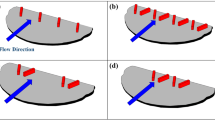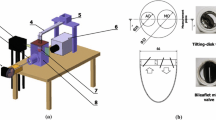Abstract
A comprehensive computational study is performed to investigate the effectiveness of vortex generators (VGs) applied to mechanical bi-leaflet heart valves. Co-rotating and counter-rotating VG configurations are compared to a control valve without VGs. Detailed flow fields are obtained and used to elucidate the underlying flow physics. It was found that VGs reduce flow separation over the leaflets and hence reduce the Reynolds shear stress (RSS) in the vicinity regions of heart valve. The co-rotating VG configuration demonstrates a better performance compared with the counter-rotating configuration in terms of the RSS, turbulent kinetic energy production and velocity distributions, especially in the peripheral jet flows. The fraction of blood damage in the co-rotating configuration shows a 4.7% reduction in comparison to the control case, while a 3.7% increase is observed in the counter-rotating configuration. The passive flow control technique of applying co-rotating VG illustrates a great potential to help mitigate the hemodynamic factors leading to potential blood damage risk.

















Similar content being viewed by others
References
Aljure, D. E., J. Calafell, A. Baez, and A. Oliva. Flow over a realistic car model: wall modeled large eddy simulations assessment and unsteady effects. J. Wind Eng. Ind. Aerodyn. 174(December 2017):225–240, 2018.
Bark, D. L., et al. Hemodynamic performance and thrombogenic properties of a superhydrophobic bileaflet mechanical heart valve. Ann. Biomed. Eng. 45(2):452–463, 2017.
Binter, C., et al. Turbulent kinetic energy assessed by multipoint 4-dimensional flow magnetic resonance imaging provides additional information relative to echocardiography for the determination of aortic stenosis severity. Circ. Cardiovasc. Imaging. 10(6):1–8, 2017.
Chandran, K. B., A. P. Yoganathan, and S. E. Rittgers. Biofluid Mechanics: The Human Circulation. Boca Raton: CRC Press, 2007.
Chnafa, C., S. Mendez, and F. Nicoud. Image-based large-eddy simulation in a realistic left heart. Comput. Fluids. 94:173–187, 2014.
Dasi, L. P., D. W. Murphy, A. Glezer, and A. P. Yoganathan. Passive flow control of bileaflet mechanical heart valve leakage flow. J. Biomech. 41(6):1166–1173, 2008.
Dasi, L. P., H. Simon, P. Sucosky, and A. P. Yoganathan. Fluid mechanics of artificial heart valves. Clin. Exp. Pharmacol. Physiol. 36(2):1–20, 2009.
Forleo, M. H. Application of passive flow control to mitigate the thromboembolic potential of bileaflet mechanical heart valves: an in vitro study. ProQuest Dissertations and Theses, p. 193, 2014.
Fu, C., M. Uddin, C. Robinson, A. Guzman, and D. Bailey. Turbulence models and model closure coefficients sensitivity of NASCAR Racecar RANS CFD aerodynamic predictions. SAE Int. J. Passeng. Cars Mech. Syst. 10(1):330–344, 2017.
Godard, G., and M. Stanislas. Control of a decelerating boundary layer. Part 1: optimization of passive vortex generators. Aerosp. Sci. Technol. 10(3):181–191, 2006.
Hatoum, H., and L. P. Dasi. Reduction of pressure gradient and turbulence using vortex generators in prosthetic heart valves. Ann. Biomed. Eng. 47(1):85–96, 2019.
Hatoum, H., S. Vallabhuneni, A. K. Kota, D. L. Bark, K. C. Popat, and L. P. Dasi. Impact of superhydrophobicity on the fluid dynamics of a bileaflet mechanical heart valve. J. Mech. Behav. Biomed. Mater. 110(July):103895, 2020.
Jackson, S. P., W. S. Nesbitt, and E. Westein. Dynamics of platelet thrombus formation. J. Thromb. Haemost. 7(SUPPL. 1):17–20, 2009.
Korteland, N. M., et al. Mechanical aortic valve replacement in non-elderly adults: meta-analysis and microsimulation. Eur. Heart J. 38(45):3370–3377, 2017.
Lin, J. C. Review of research on low-profile vortex generators to control boundary-layer separation. Prog. Aerosp. Sci. 38(4–5):389–420, 2002.
Mittal, R., S. P. Simmons, and H. S. Udaykumar. Application of large-eddy simulation to the study of pulsatile flow in a modeled arterial stenosis. J. Biomech. Eng. 123(4):325–332, 2001.
Murphy, D. W., L. P. Dasi, J. Vukasinovic, A. Glezer, and A. P. Yoganathan. Reduction of procoagulant potential of b-datum leakage jet flow in bileaflet mechanical heart valves via application of vortex generator arrays. J. Biomech. Eng. 132(7):1–10, 2010.
Rayz, V. L., et al. Flow residence time and regions of intraluminal thrombus deposition in intracranial aneurysms. Ann. Biomed. Eng. 38(10):3058–3069, 2010.
Sotiropoulos, F., T. B. Le, and A. Gilmanov. Fluid mechanics of heart valves and their replacements. Annu. Rev. Fluid Mech. 48(1):259–283, 2016.
Garon, A., and M. Farinas. Fast three-dimensional numerical hemolysis approximation. Artificial Organs. 28(11):1016–1025, 2004.
Wriggers, P., and T. Lenarz. Biomedical technology: Modeling, experiments and simulation, Vol. 84, Berlin: Springer, 2018.
Yang, J., and E. Balaras. An embedded-boundary formulation for large-eddy simulation of turbulent flows interacting with moving boundaries. J. Comput. Phys. 215(1):12–40, 2006.
Yoganathan, A. P., Z. He, and S. Casey Jones. Fluid mechanics of heart valves. Annu. Rev. Biomed. Eng. 6(1):331–362, 2004.
Funding
The research done was partly supported by National Institutes of Health (NIH) under Award Numbers R01HL135505 and R21HL139208.
Conflict of interest
Dr. Dasi report a patent on developing blood-compatible polymers, an invention disclosure for polymeric valved conduit fabrication and durability optimization of heart valves, patents for designing prosthetic heart valves and vortex generators on heart valves. Dr. Dasi is the founder of YoungHeartValve LLC and Dasi Simulations LLC. Dr. Hatoum reports having filed a patent application on computational predictive modeling of thrombosis in heart valves and on a Novel Implantable Vascular Shunt with Real-Time Precise Flow Control.
Author information
Authors and Affiliations
Corresponding author
Additional information
Associate Editor Jane Grande-Allen oversaw the review of this article.
Publisher's Note
Springer Nature remains neutral with regard to jurisdictional claims in published maps and institutional affiliations.
Rights and permissions
About this article
Cite this article
Wang, Z., Dasi, L.P. & Hatoum, H. Controlling the Flow Separation in Heart Valves Using Vortex Generators. Ann Biomed Eng 50, 914–928 (2022). https://doi.org/10.1007/s10439-022-02966-5
Received:
Accepted:
Published:
Issue Date:
DOI: https://doi.org/10.1007/s10439-022-02966-5




